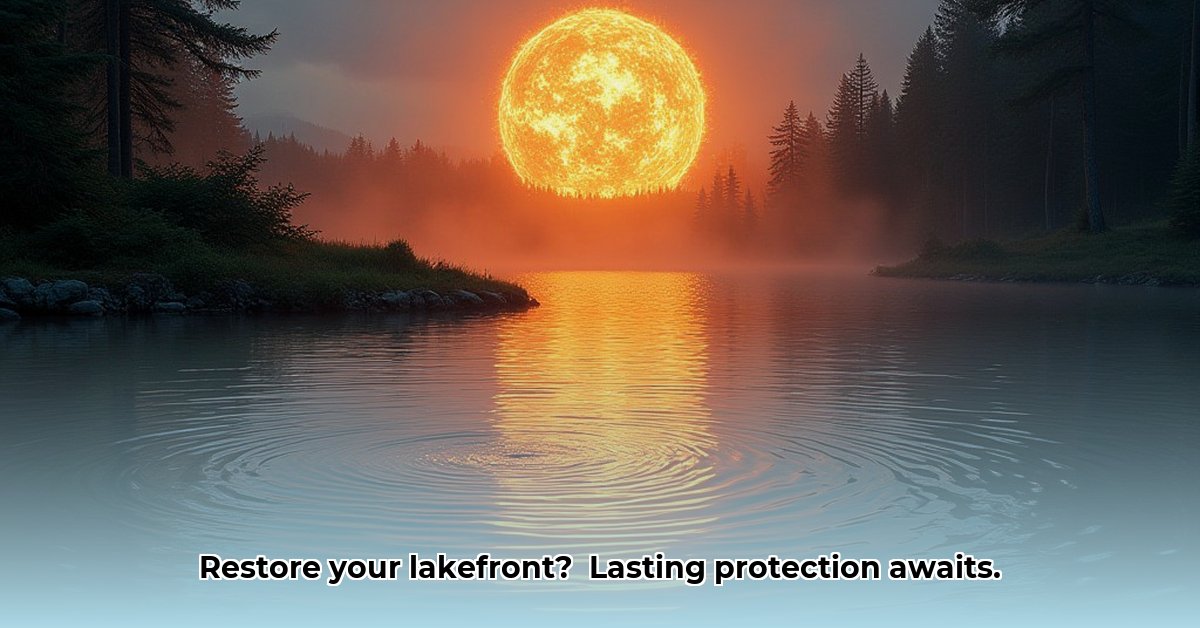
Lakefront Restorers: Protecting Your Precious Shoreline
Imagine your idyllic lakefront retreat, slowly eroding away. Rising waters, increasingly powerful storms, and the relentless forces of nature are silently stealing your precious shoreline. But there's hope. Lakefront restorers are shoreline superheroes, employing innovative techniques to protect and restore your valuable lakeside property. This article guides you through understanding shoreline erosion, choosing the right restoration methods, and navigating the process to ensure lasting protection for your lakefront investment.
Understanding the Enemy: Shoreline Erosion and Its Impacts
Shoreline erosion isn't merely a cosmetic issue; it's a significant threat. Climate change exacerbates the problem, with rising lake levels and more intense storms relentlessly chipping away at shorelines. This isn't just about losing a bit of land; it’s about potential structural damage, decreased property value, and harm to the delicate lake ecosystem. The cumulative effects can be devastating, impacting both your financial well-being and the surrounding environment. How can we effectively combat this pervasive threat?
Calling in the Experts: How Lakefront Restorers Save the Day
Lakefront restorers utilize a variety of techniques to combat erosion, each tailored to specific circumstances. These methods often work in synergy, creating a comprehensive approach to shoreline protection.
Replenishing the Beach (Beach Nourishment and Sediment Delivery): This involves adding sand or sediment to reinforce the beach, creating a natural buffer against wave action. Think of it as bolstering your shoreline's defenses, providing a wider, more resilient barrier.
Harnessing Nature's Power: Vegetation Management: Planting native vegetation strengthens the shoreline by binding soil together, preventing erosion. These plants act as natural anchors, stabilizing the ground and creating a more robust defense against the elements. The added benefit? Improved water quality and enhanced biodiversity.
High-Tech Solutions: Sonar and Other Tools: Advanced technology, such as sonar, helps assess erosion and guide restoration efforts. Sonar creates detailed maps of the lakebed, pinpointing vulnerable areas for targeted action. This ensures the most efficient use of resources. Some advanced techniques include surfactants (chemicals that alter surface tension), sometimes used to address harmful algal blooms that can exacerbate erosion.
Choosing Your Shoreline Savior: Selecting the Right Lakefront Restorer
Selecting the right lakefront restorer is a critical decision. Don’t rush the process; thorough research is essential.
Gather Multiple Quotes: Obtain detailed quotes from at least three reputable firms, comparing proposed solutions, pricing, and timelines. A detailed breakdown of services is imperative.
Verify Credentials and Licensing: Ensure the restorer holds the necessary licenses and insurance. Check online reviews and request references to ascertain their reputation and past performance.
Evaluate Experience and Expertise: Look for experience specific to your type of erosion and the local environment. Inquire about their approach to sustainability. A strong track record is crucial for a successful project. "Experience really matters here," says Dr. Emily Carter, Hydrologist at the Environmental Protection Agency. "Choosing someone with proven success in your specific geographic area can significantly increase the likelihood of a successful project."
Understand Long-Term Costs: Don't solely focus on the initial investment; factor in ongoing maintenance. A well-informed professional will provide clear information on the expected lifespan of the restoration materials, potential future maintenance and the associated cost implications.
Navigating the Regulatory Waters: Permits and Regulations
Before commencing any project, familiarize yourself with local regulations and obtain the necessary permits. Requirements vary by jurisdiction. Working with a lakefront restorer experienced in navigating these regulations streamlines the process and mitigates potential legal complications.
Long-Term Vision: Sustainable Solutions for Lasting Protection
Sustainable solutions are key for long-term success. Methods like native plant landscaping are environmentally friendly, offering both immediate erosion control and long-term ecological benefits. They minimize maintenance over time, making them economically sensible in the long run. Dr. Michael Davis, Professor of Environmental Science at the University of Michigan, adds, "Thinking long-term pays dividends. Eco-friendly solutions tend to reduce maintenance costs, protect biodiversity, and improve overall water quality, leading to a better overall value for your investment."
Weighing Your Options: A Risk Assessment
Different restoration methods carry various levels of risk and environmental impact. This table offers a general overview; however, a site-specific assessment is essential.
| Technology/Method | Risk of Failure | Environmental Impact | Regulatory Hurdles | Cost | Long-Term Maintenance |
|---|---|---|---|---|---|
| Sediment Delivery | Moderate | Low to Moderate | Moderate | High | Moderate |
| Beach Nourishment | Moderate | Low to Moderate | Moderate | High | Moderate to High |
| Vegetation Management | Low | Low | Low | Moderate | Low |
| Sonar/Surfactant Use | Low to Moderate | Low to Moderate | Moderate | Moderate | Low |
| Native Plant Landscaping | Low | Positive | Low to Moderate | Moderate | Low |
Case Study: A Successful Shoreline Restoration
A community in Wisconsin successfully utilized a combined approach of beach nourishment and native vegetation planting. While the initial investment was higher, the long-term benefits – reduced erosion, improved water quality, and enhanced biodiversity—clearly demonstrated the cost-effectiveness of a comprehensive, eco-friendly solution.
Choosing the right lakefront restorer is a significant investment in your property's future. By understanding the challenges of erosion and selecting a qualified professional, you can safeguard your lakefront paradise for generations to come. Don’t wait until the damage is irreversible; act today.